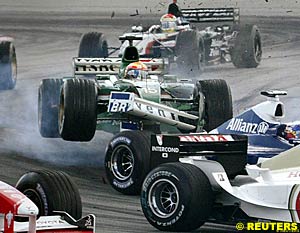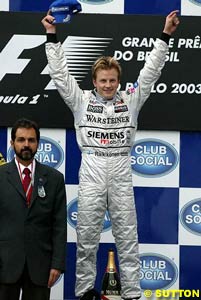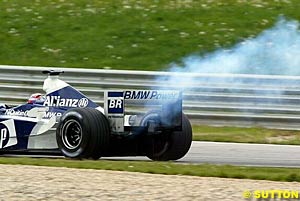
Atlas F1 Magazine Writer
This season, more than any other season in recent years, was a season of 'could have been'. Championship contenders retired from hopeful positions and post-race FIA decisions either did or did not impact the results. With the season now over and the Championship concluded, fans - and perhaps the drivers themselves - inevitably dwell on the 'what ifs', the missed opportunities that could have changed the outcome of the year. Atlas F1's Marcel Schot looks at some of those strokes of fortune, and hypothesizes on how things would have panned out if they hadn't happened.
Lets keep Montoya's first few laps the same as those drivers around who he was when the collision happened, Raikkonen and Button, and also add three more laps at the end of the race at an average pace. In the first lap the Williams driver lost about 17 seconds, followed by 3 minutes and 57 seconds during the prolonged pitstop. Towards the end of the race most drivers were averaging 1:38.5s.
Montoya completed his race three laps short in 1:32:39.485. If we subtract the 4 minutes and 14 seconds he lost in the beginning and add the 4 minutes and 55.5 seconds he might have done at the end of the race, that puts Montoya's finishing time 41.5 seconds slower than his real time, at 1:33:21.0, good enough to beat Fernando Alonso for third by five seconds.
This would have given the Williams driver the points he needed to stay in the championship battle until Suzuka. Michael Schumacher would have lost a point, Montoya gained six. Before Suzuka that would have put Schumacher on 91, Montoya on 88 and Raikkonen on 83. This would have provided the first final race championship decider among more than two drivers since 1986!
Giancarlo Fisichella overtook Kimi Raikkonen and the race was red flagged. Raikkonen was declared the winner, but five days later the FIA decided that Fisichella was the winner after all, because the leaders had just completed their lap and thus the result of lap 54 rather than lap 53 should count.
Just two points difference, but how the season could have changed. Raikkonen's lead towards Schumacher would have been bigger in the first half of the season, possibly laying somewhat less pressure on the young Finn. However, when we bring this result towards the end of the season, the Japanese Grand Prix would have shown a completely different story.
Raikkonen would have started seven points behind Schumacher and would effectively be in World Championship position from lap 27 on. This would have put Michael Schumacher under considerably more pressure to climb to eight position. It's impossible to tell what would have happened, but it's sure it would have been more exciting than what we actually saw in Suzuka.
At the time Montoya was going slightly faster than Kimi Raikkonen, while Michael Schumacher overtook the Finn and showed clearly that the McLaren driver had been holding him up. The Ferrari driver opened an eight second gap on Raikkonen in ten laps. This would indicate that Schumacher would have been all over Montoya in a matter of laps. As the second pitstop for Schumacher was a quick one, it would seem unlikely that Montoya would have gotten a win had he finished the race. However, a second place is a logical assumption, with the Colombian being slightly faster than the eventual number two, Raikkonen.
Had the rest of the season run as it did, we would have seen a very different scenario at Suzuka. The race would have started with Schumacher at 92 points, Montoya at 90 and Raikkonen out of the picture at 81 points. However, we would have likely seen different racing before that.
The question is, what was Raikkonen's pitstop strategy? A comparison with Michael Schumacher's strategy shows they both had their first stop in the same lap, with Raikkonen substantially faster over the first stretch. After the stop, the McLaren driver drove half a second per lap faster than Schumacher. Comparing this to the ten seconds Raikkonen was faster over the first 15 laps more or less throws the idea of a three stopper out the window. In this case Raikkonen would probably have won the race easily.
The result would see Raikkonen in the lead of the championship. With Michael Schumacher's difficult period in the following races, the Ferrari driver would have been under a lot more pressure at Monza with Raikkonen seven points ahead of him. Bringing forth the situation to Suzuka, we'd have seen Raikkonen leading the championship with 93, Schumacher following with 91 and Montoya out of the picture with 80 points.
Even though Coulthard was close before the puncture, there was no reason to assume that the McLaren driver would have overtaken Schumacher in the final laps of the race. Therefore assuming a second place for the World Champion seems obvious.
This would not have affected the other two championship contenders, as Montoya won the race comfortably and Kimi Raikkonen had retired after a startline collision with Rubens Barrichello. However, the six extra points would have been enough for Schumacher to clinch the title in the second to last race in America.
The top seven drivers would have been disqualified, giving a result where only five drivers were classified : Michael Schumacher, Nick Heidfeld, Jenson Button, Jos Verstappen and Nicolas Kiesa. This would have meant a championship decider at Indianapolis rather than Suzuka as well as points for Minardi, with the financial injection that goes with it.
In the unlikely event that all of the above would have happened, the championships would have looked very much the same, even though the points distribution would have been quite different. Of the drivers with more than two races driven, only Ralph Firman, Jacques Villeneuve and Antonio Pizzonia would have been unaffected by the above scenarios. The Constructors' Championship would have ended the same as it really did when we look at the positions and for the Drivers' Championship we have to go all the way down to number 12 to see a change in positions.
 After a collision with Jaguar driver Antonio Pizzonia in the first corner, the race was more or less over for Montoya. The Williams driver had to pit for a new rear wing, which didn't go well at all, causing him to suffer a 3 lap delay.
After a collision with Jaguar driver Antonio Pizzonia in the first corner, the race was more or less over for Montoya. The Williams driver had to pit for a new rear wing, which didn't go well at all, causing him to suffer a 3 lap delay.
 Right at the end of an already spectacular Brazilian Grand Prix, Jaguar driver Mark Webber crashed coming onto the start finish straight. The safety car came on track immediately, but that didn't prevent Fernando Alonso ploughing into the debris and crashing heavily himself.
Right at the end of an already spectacular Brazilian Grand Prix, Jaguar driver Mark Webber crashed coming onto the start finish straight. The safety car came on track immediately, but that didn't prevent Fernando Alonso ploughing into the debris and crashing heavily himself.
 After initially falling behind Michael Schumacher, Juan Pablo Montoya quickly made up ground when it started to rain. After the first series of pitstops the Colombian came out the leader, but the problems were apparent by then. The water pressure in his Williams was dropping and retirement was inevitable.
After initially falling behind Michael Schumacher, Juan Pablo Montoya quickly made up ground when it started to rain. After the first series of pitstops the Colombian came out the leader, but the problems were apparent by then. The water pressure in his Williams was dropping and retirement was inevitable.
 Starting the race from Pole Position, Kimi Raikkonen quickly pulled a gap to Ralf Schumacher in second. By the time of the Finn's first pitstop, on lap 16, he was nearly nine seconds ahead. The younger Schumacher stopped five laps later, giving the lead back to Raikkonen. The McLaren driver was a steady five seconds ahead when his engine blew four laps later.
Starting the race from Pole Position, Kimi Raikkonen quickly pulled a gap to Ralf Schumacher in second. By the time of the Finn's first pitstop, on lap 16, he was nearly nine seconds ahead. The younger Schumacher stopped five laps later, giving the lead back to Raikkonen. The McLaren driver was a steady five seconds ahead when his engine blew four laps later.
 With four laps to go in the German Grand Prix, Michael Schumacher was in second with McLaren's David Coulthard close behind him. Then the Ferrari driver suffered a puncture on his left rear tyre, dropping him to seventh place at the end of the race.
With four laps to go in the German Grand Prix, Michael Schumacher was in second with McLaren's David Coulthard close behind him. Then the Ferrari driver suffered a puncture on his left rear tyre, dropping him to seventh place at the end of the race.
 After the Hungarian Grand Prix the FIA clarified the rules on tyre width, thereby warning Michelin. However, the results weren't adapted. Of course, the impact would have been much more than just a huge shake up in the race result. In fact, a mass disqualification might have caused further withdrawals from Michelin teams and surely the biggest distress in the Formula One paddock in the last 20 years.
After the Hungarian Grand Prix the FIA clarified the rules on tyre width, thereby warning Michelin. However, the results weren't adapted. Of course, the impact would have been much more than just a huge shake up in the race result. In fact, a mass disqualification might have caused further withdrawals from Michelin teams and surely the biggest distress in the Formula One paddock in the last 20 years.
Drivers' Championship Constructors' Championship
1. Michael Schumacher 108 1. Ferrari 171
2. Kimi Raikkonen 101 2. Williams 150
3. Juan Pablo Montoya 94 3. McLaren 149
4. Rubens Barrichello 63 4. Renault 82
5. Ralf Schumacher 52 5. BAR 29
6. Fernando Alonso 52 6. Sauber 27
7. David Coulthard 48 7. Jaguar 16
8. Jarno Trulli 30 8. Toyota 14
9. Jenson Button 20 9. Jordan 11
10. Mark Webber 15 10. Minardi 9
11. H.H. Frentzen 15
12. Nick Heidfeld 12
13. Giancarlo Fisichella 10
14. Cristiano Da Matta 9
15. Jacques Villeneuve 6
16. Jos Verstappen 5
17. Marc Gene 4
18. Nicolas Kiesa 4
19. Takuma Sato 3
20. Ralph Firman 1
21. Justin Wilson 1
Please Contact Us for permission to republish this or any other material from Atlas F1.
|
Volume 9, Issue 45
Atlas F1 Special
The Knock on the Door
2003 Season Review
The Season of What If
How Would F1 Score in Other Series
Columns
The Fuel Stop
Rear View Mirror
Bookworm Critique
On the Road
Elsewhere in Racing
The Weekly Grapevine
> Homepage |